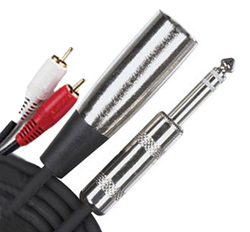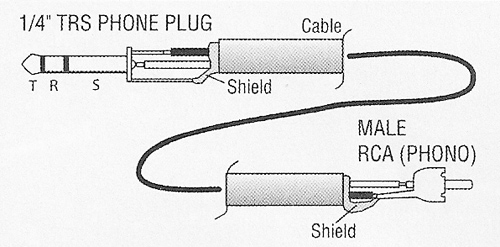
Note that the balanced signals are 12 dB higher in level than unbalanced signals.
So what happens when a balanced output is connected to an unbalanced input. Most likely, the signal will be 12 dB too high for the unbalanced equipment, which overloads the input and can cause distortion – a gritty sound.
In other words, the unbalanced device is “expecting to see” a -10 dBV signal at its input, but it’s getting a +4 dBu signal instead – again, 12 dB too high.
Some audio equipment has a “+4/-10” level switch, and this must be set so that the levels of the console and recorder match. For example, if the recorder has RCA inputs, which are unbalanced, its normal operating level is -10.
So also set the output level switch on the console to -10, and connect the mixer directly to the recorder.
If the console lacks a +4/-10 switch, the signal level can be reduced by 12 dB with the use of a pad, which is a simple circuit made of two resistors (Figure 2).
With the pad in place, the signal will be the correct level going into the recorder, and so there will be no distortion.

THE CLEANEST SIGNAL
Figure 2 also shows four ways to connect a mixer’s XLR or TRS connector to a recorder’s RCA or phone-jack connector. If you don’t know what type of output circuitry your console has, try each of the top three connections and find out which one provides the cleanest signal.
Sometimes the connections can cause hum. If that happens, a 1:1 transformer will need to be installed between the two devices. (This is specifically shown in the bottom illustration of Figure 2.)
The cause of the hum is a ground loop, which occurs when the chassis of two audio devices are connected to the building’s safety ground through their power cords, and also are connected to each other through a cable shield.
The chassis of the two devices may be at different ground voltages, especially if they are plugged into different AC outlets. This causes a 60 Hz current to flow between them along the cable shield.
